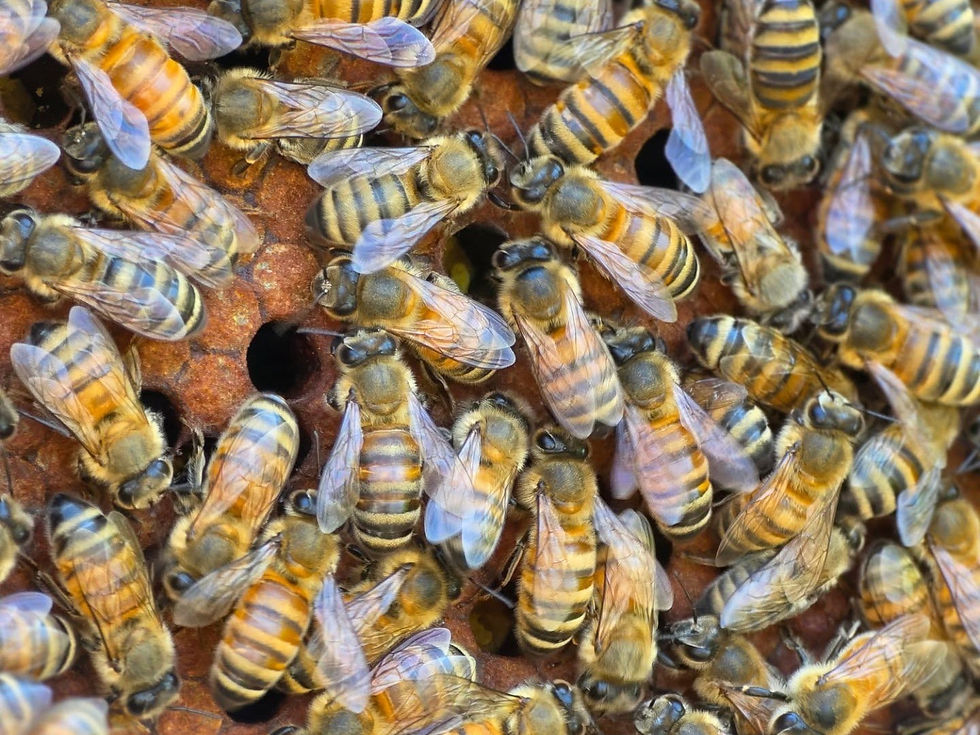Nectar Flow
- Zack

- May 21
- 3 min read

If you have talked with a beekeeper you will have hear the term Nectar Flow or Honey Flow. Here in Maryland, we are just finishing up this year's nectar flow, meaning the majority of flowers that bees feed on are done blooming.
Clover has just come into bloom, and tulip poplar is on its way out. Here, our tulip poplar season often comes in really short because of mid-spring thunderstorms. Usually, the bees will have a chance to start foraging on tulip poplar, but it ends before the delicious honey is made.
Tulip poplar has a dark look to it and an exceptional taste that is very fruity and delicate. Isolating a honey variety takes precision and understanding of what it looks like. In the comb, honey may have different colors, but the bees will fill the comb with like nectar and will not mix it.
As a beekeeper, you have to go in and identify which nectar is which with light colored foundation, or it may be too hard to determine the changes in honey. You want blueberry honey? Well, you need a lot of blueberry plants in the area from which the bees can get their primary nectar. The varietal honey is a tedious task typically able to be produced by migrating hives of a commercial beekeeper.
The nectar flow is one of the most important periods in the life of a bee colony and a critical concept for beekeepers to understand.
What is the Nectar Flow?
The nectar flow refers to the time of year when flowering plants produce large amounts of nectar, which honey bees collect to make honey. During this time, bee colonies often grow rapidly and store surplus honey, making it a peak season for honey production.
Key Characteristics of the Nectar Flow:
Aspect | Description |
Timing | Depends on climate and location. In many areas, the main nectar flow is in spring to early summer. Some regions also have fall flows from plants like goldenrod or aster. |
Duration | Usually lasts a few weeks to a couple of months. The peak can be short—just a few intense weeks. |
Sources of Nectar | Comes from trees (e.g., black locust, tulip poplar), shrubs, and wildflowers (clover, dandelion, goldenrod). |
Colony Behavior | Bees work longer hours, foraging early in the morning until late evening. Queen laying often increases. Hive population expands. |
Why is it Important for Beekeepers?
Honey Harvest: This is when surplus honey can be collected—after making sure bees have enough for themselves.
Hive Expansion: Colonies can grow quickly, so beekeepers must add space (supers) to prevent swarming.
Swarm Risk: Rapid growth increases swarming tendency. Monitoring and swarm control is critical.
Feeding Stops: You typically don’t need to feed bees during the flow—they’re self-sufficient.
After the Nectar Flow:
Dearth Period: This is a nectar shortage—can lead to aggression, robbing behavior, and colony stress.
Fall Management: Beekeepers assess food stores, mite levels, and prepare the colony for winter.
Tips for New Beekeepers:
Know Your Local Flow: Timing varies by region. Join a local beekeeping club to learn specific timing.
Watch the Weather: A rainy or dry season can impact nectar production.
Add Supers Early: Don’t wait—if bees run out of space, they may swarm.
Observe the Bees: Heavy foraging, white wax on combs, and increasing weight are signs of a flow.
Keep a Bee Journal: Document your local flora and when it blooms each year. This creates predictability and allows you, as the beekeeper, to anticipate when and how you should super your hives. Need more help? Send me a message or reach out to your local bee club.




Comments